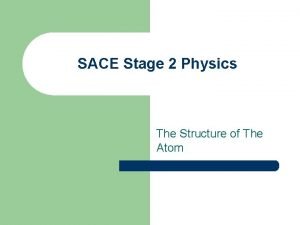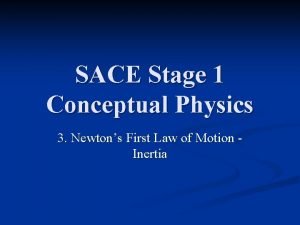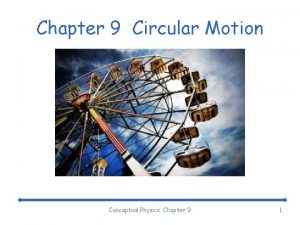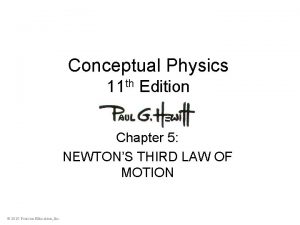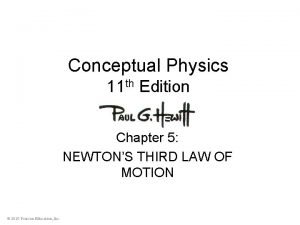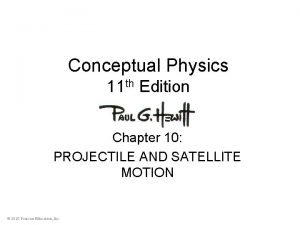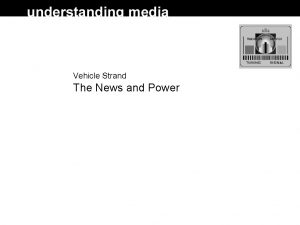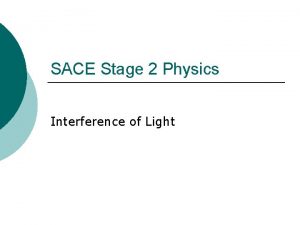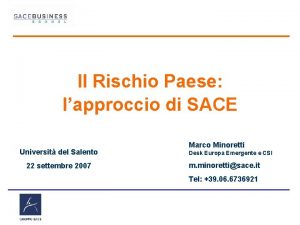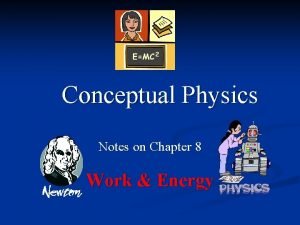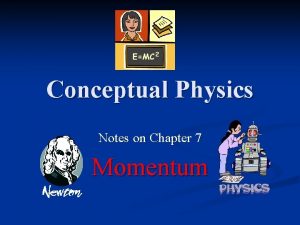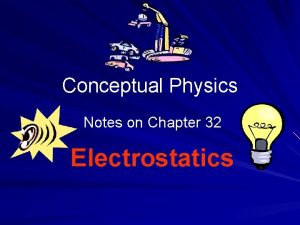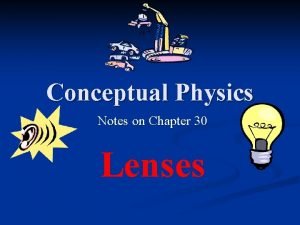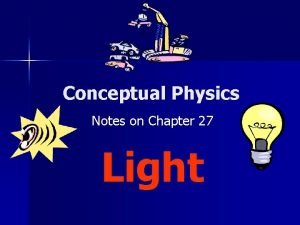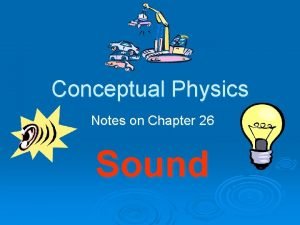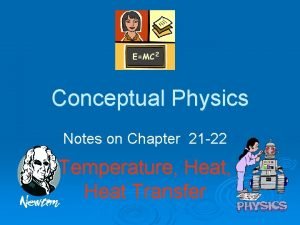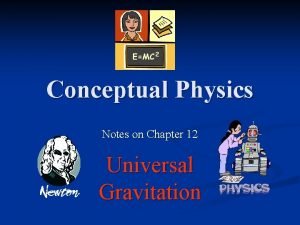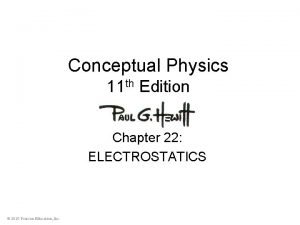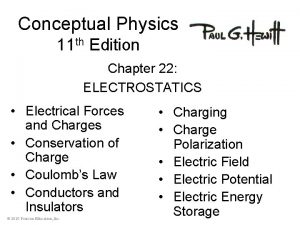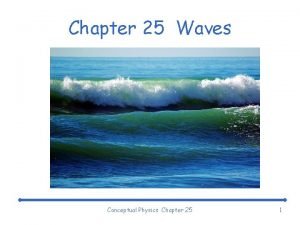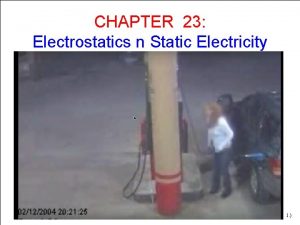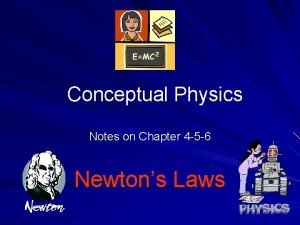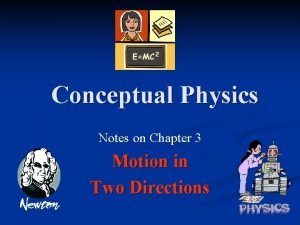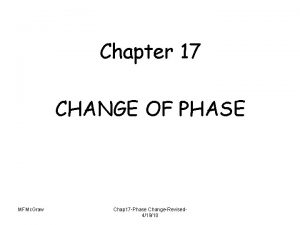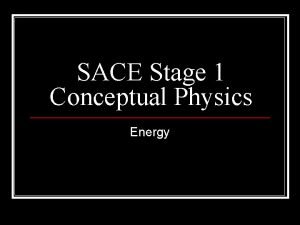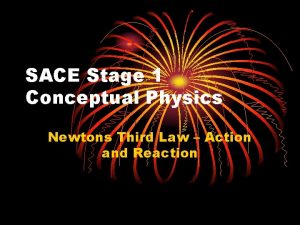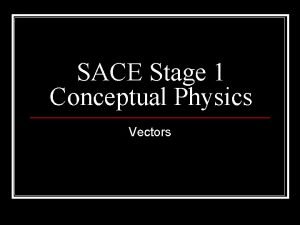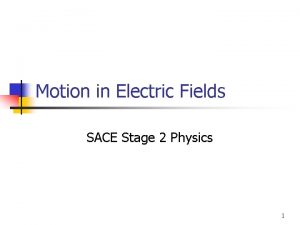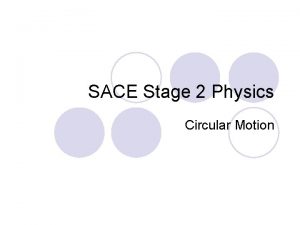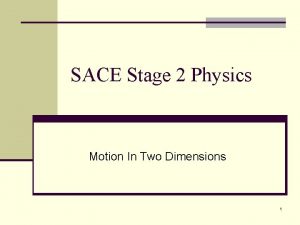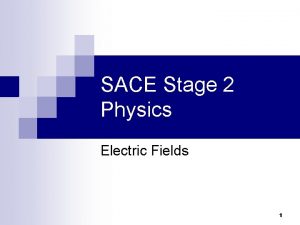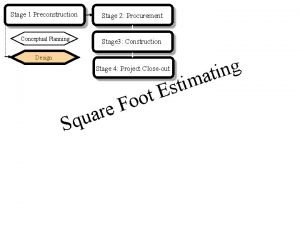SACE Stage 1 Conceptual Physics 2 Motion 2














































- Slides: 46

SACE Stage 1 Conceptual Physics 2. Motion

2. 1 Motion is Relative Everything moves. Things that appear to be at rest move. l They move relative to the Earth, Sun and the stars. l A book at rest on the table is moving, it is moving at about 30 km/s relative to the sun. l

2. 1 Motion is Relative We describe the motion of an object as relative to something else. l When a car has reached 60 km/hr, it has reached 60 km/hr relative to the ground. l Unless stated otherwise, when we describe speed in nature, assume it is relative to the ground. l

2. 2 Speed Moving objects will cover a certain distance in a given time. l A car travels in km/hr. (Distance / Time) l Speed is the measure of how fast something is moving. l It is the rate at which distance is covered. l

2. 2 Speed l When we see the word Rate in a statement, we know that something is being divided by time.

2. 2 Speed l Table 2. 1 – Approximate Speeds in different units. 20 km/hr 40 km/hr 60 km/hr 80 km/hr 100 km/hr 120 km/hr = = = 12 mi/hr 25 mi/hr 37 mi/hr 50 mi/hr 62 mi/hr 75 mi/hr = = = 6 m/s 11 m/s 17 m/s 22 m/s 28 m/s 33 m/s

2. 2 Speed – Instantaneous Speed l The speed of an object at a particular point in time is called its instantaneous speed.

2. 2 Speed – Average Speed l Average speed is the total distance covered divided by the total time taken to travel that distance.

2. 2 Speed – Average Speed l Average Speed is an easy calculation. l If it takes 4 hours to cover 240 km. What is your Average Speed?

2. 2 Speed – Average Speed Calculation

2. 2 Speed – Question 1 l With the Speedometer in the dash of every car is an odometer, which records the distance travelled. If the initial reading is set to zero at the beginning of a trip and the reading is 35 km one-half hour later, what has been your average speed?

2. 2 Speed – Question 1 Answer

2. 2 Speed – Question 2 l Would it be possible to attain this average speed and never exceed the 70 km/hr?

2. 2 Speed – Question 2 Answer l No, not if the trip started from rest. For any period of time when the car was travelling less than 70 km/hr, there would have to be periods of time where the car travelled greater than 70 km/hr to be able to attain an average speed of 70 km/hr.

2. 2 Speed – Question 3 l If a cheetah can maintain a constant speed of 25 m/s, it will cover 25 m every second. At this rate, how far will it travel in 10 s? 1 minute?

2. 2 Speed – Question 3 Answer l When can re arrange our formula to allow us to work out the distance travelled.

2. 3 Velocity What is the difference between speed and velocity? l Velocity is a speed in a given direction. l A car that is travelling at 60 km/hr has speed but when we say 60 km/hr North, it now has velocity. l

2. 3 Velocity – Question l The speedometer in a car moving northward reads 60 km/hr. It passes another car that travels at 60 km/hr Southward. Do both cars have the same speed? Do they have the same velocity?

2. 3 Velocity – Question Answer l Both cars have the same speed but will have opposite velocities as they are travelling in opposite directions.

2. 3 Velocity – Constant Velocity To achieve constant velocity, it is reasonable to see that an object must have constant speed and constant direction. l Motion at constant velocity is motion in a straight line. l

2. 3 Velocity – Changing Velocity If either the speed or direction change, then velocity has changed. l In a car there are three things that can change velocity. The accelerator increases speed, the brake decreases speed and the steering wheel changes the direction. l

2. 4 Acceleration describes how velocity is changing. l Velocity can change by changing its speed or direction. l Although the moon that orbits the Earth isn’t changing it’s speed, it is accelerating as it is changing it’s direction. l

2. 4 Acceleration

2. 4 Acceleration When driving a car, there is 3 ways to accelerate. l Speed up, slow down or change direction. l

2. 4 Acceleration – Question 1 l Suppose a car moving in a straight line steadilty increases its speed each second, first from 35 – 40 km/hr, then from 40 - 45 km/hr, then from 45 – 50 km/hr. What is its acceleration?

2. 4 Acceleration – Question 1 Answer l We see that the speed increases by 5 km/hr during each 1 s interval. The acceleration is therefore 5 km/hr each second.

2. 4 Acceleration – Question 2 l In 5 seconds a car is moving in a straight line changes its speed from 50 km/hr to 65 km/hr while a truck goes from rest to 15 km/hr in a straight line. Which undergoes the greater acceleration? What is the acceleration of each vehicle.

2. 4 Acceleration – Question 2 Answer l The car and the truck both increase their speeds by 15 km/hr over the same time interval so therefore have achieved the same acceleration.

2. 5 Free Fall Drop something, it falls. Does it accelerate? l Gravitation causes things to accelerate when they are dropped. l If the object is dropped and air resistance has been removed, the object is said to be in free fall. l

2. 5 Free Fall l Free falling objects are said to be under the influence of gravity alone. Elapsed Time (s) Instantaneous speed (m/s) 0 0 1 10 2 20 3 30 4 40 . . . t 10 t

2. 5 Free Fall l l Note that in the previous table how the speed changed each second. During free fall, the instantaneous speed changed by 10 m/s. The speed gain each second is its acceleration.

2. 5 Free Fall - Question l What would the speedometer reading on the falling rock shown be 4. 5 s after it drops from rest? How about 8 s after it has dropped? 100?

2. 5 Free Fall – Question Answer l The speedometer readings would be 45 m/s, 80 m/s and 1000 m/s, respectively. You can reason this from the table on the previous slide or use the equation v=gt where g = 10 m/s (gravity) = 10 m/s 2.

2. 5 Free Fall What about its upward path? l During the upward motion its velocity is constantly changing so it must accelerating, even when it is momentarily still at the top. l Acceleration due to gravity (10 m/s 2) is always constant. l

2. 6 Free Fall: How far? l l How far something falls and how fast it falls are 2 different things! After 1 s, an object will fall 5 m. What is its average Speed?

2. 6 Free Fall: How far? Question 1 l Consider the table on the previous slide, during the span of the second time inerval, the object begins at 10 m/s and ends at 20 m/s. What is the average speed of the object during this 1 s interval? What is its acceleration?

2. 6 Free Fall: How far? Question 1

2. 6 Free Fall: How far? l Table 2 -3 Free-Fall distances of Object dropped from Rest. Elapsed Time (s) Distance Fallen (m) 0 0 1 5 2 20 3 45 4 80 5 125 . . t ½gt 2

2. 6 Free Fall: How far? Question 2 l An apple drops from a tree and hits the ground in 1 second. What is its speed upon striking the ground? What is its average speed during the 1 second? How high above the ground was it when it first dropped?

2. 6 Free Fall: How far? Question 2

2. 7 Air Resistance and Falling Objects Drop a heavy book and a piece of paper and it is obvious that the book hits the ground first. l As the paper has less mass, the air affects it more than the book. l Remove air resistance and both fall at the same rate. l All things fall at the same rate (9. 8 m/s 2) l

2. 8 Chapter Review Motion is described relative to something. l Speed is the rate at which distance is covered measured in units of distance divided by time. l l Instantaneous speed is the speed at any instant. l Average speed is the total distance covered divided by the time interval.

2. 8 Chapter Review l Velocity is the speed together with the direction of travel. l Velocity is constant only when the speed and direction are constant (a straight line motion)

2. 8 Chapter Review l Acceleration is the rate at which velocity is changing with respect to time. l An object accelerates when its speed is increasing, when its speed is decreasing and/or its direction is changing. l Acceleration is measured in units of speed divided by time.

2. 8 Chapter Review l An object in free fall is falling under the influence of gravity alone, where air resistance does not affect its motion. l An object in free fall has a constant acceleration of about 10 m/s 2.

2. 8 Chapter Review l Important Terms l Acceleration (2. 4) l Average speed (2. 2) l Elapsed time(2. 5) l Free Fall (2. 5) l Instantaneous Speed (2. 2) l Rate (2. 1) l Relative (2. 1) l Speed (2. 2) l Velocity (2. 3)
 Sace stage 2 physics
Sace stage 2 physics Sace stage 2 physics
Sace stage 2 physics Sace stage 1 physics
Sace stage 1 physics Sace stage 2
Sace stage 2 Chapter 9 circular motion answers
Chapter 9 circular motion answers Slightly tilted wings of airplanes deflect
Slightly tilted wings of airplanes deflect Conceptual physics chapter 5 newton's third law of motion
Conceptual physics chapter 5 newton's third law of motion Conceptual physics chapter 3 linear motion
Conceptual physics chapter 3 linear motion Conceptual physics projectile motion
Conceptual physics projectile motion Sace scaling
Sace scaling Cptd management system
Cptd management system Plato sace
Plato sace Reinforcement and annulment of waves
Reinforcement and annulment of waves Scheda paese sace
Scheda paese sace Sace english literary studies
Sace english literary studies Sace annual report
Sace annual report Sace center
Sace center Sace export plus
Sace export plus Conceptual physics notes
Conceptual physics notes Conceptual physics chapter 7
Conceptual physics chapter 7 Conceptual physics chapter 35 electric circuits
Conceptual physics chapter 35 electric circuits Conceptual physics chapter 33
Conceptual physics chapter 33 Chapter 32 electrostatics conceptual physics
Chapter 32 electrostatics conceptual physics Chapter 30 lenses
Chapter 30 lenses Conceptual physics chapter 27 light pdf
Conceptual physics chapter 27 light pdf Conceptual physics chapter 26
Conceptual physics chapter 26 Conceptual physics chapter 21
Conceptual physics chapter 21 Conceptual physics chapter 13 universal gravitation
Conceptual physics chapter 13 universal gravitation Conceptual physics momentum
Conceptual physics momentum Chapter 24 magnetism magnetic fundamentals answers
Chapter 24 magnetism magnetic fundamentals answers Conceptual physics chapter 22 electrostatics
Conceptual physics chapter 22 electrostatics Conceptual physics chapter 22 electrostatics
Conceptual physics chapter 22 electrostatics Chapter 25 concept review physics waves
Chapter 25 concept review physics waves Conceptual physics chapter 23 electric current
Conceptual physics chapter 23 electric current Conceptual physics notes
Conceptual physics notes Conceptual physics notes
Conceptual physics notes Conceptual physics chapter 17 change of phase answers
Conceptual physics chapter 17 change of phase answers Circular motion conceptual questions
Circular motion conceptual questions Stage 1: denial
Stage 1: denial Staging drama definition
Staging drama definition Disadvantage of thrust stage
Disadvantage of thrust stage Single stage tender
Single stage tender What is drama
What is drama Stage right stage left diagram
Stage right stage left diagram Modern physics vs classical physics
Modern physics vs classical physics University physics with modern physics fifteenth edition
University physics with modern physics fifteenth edition Ib physics ia topics
Ib physics ia topics

